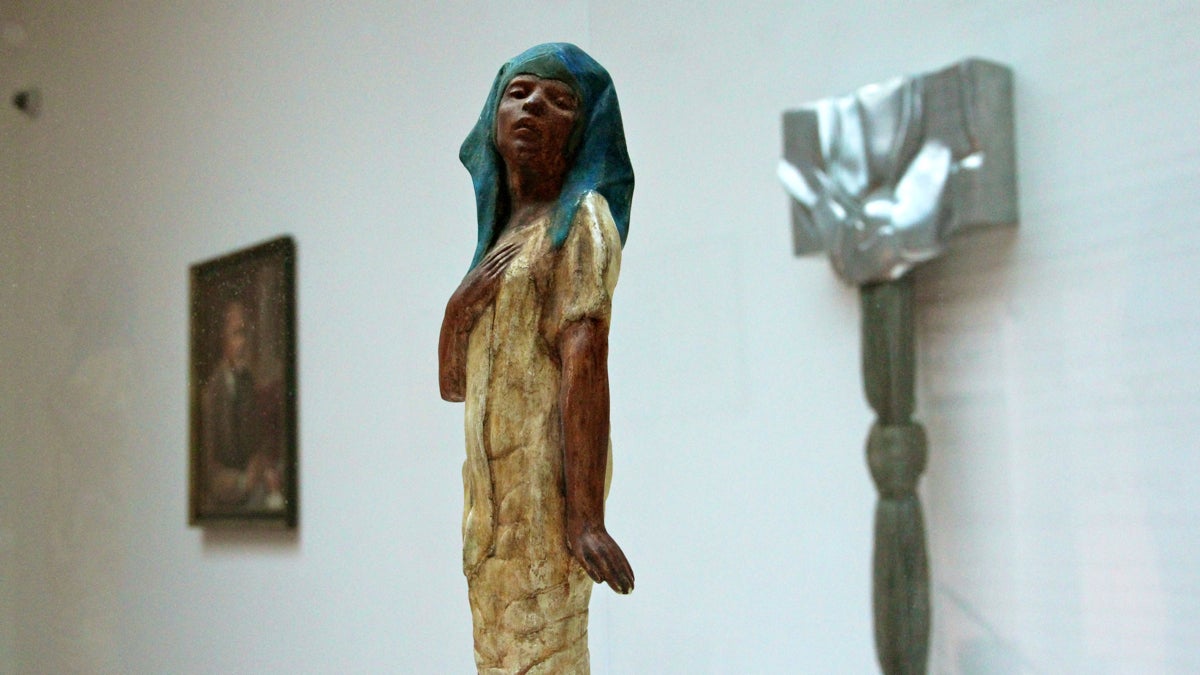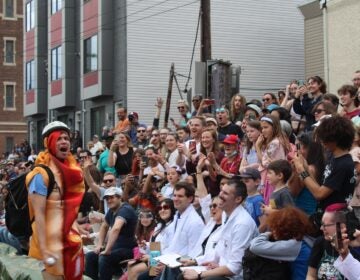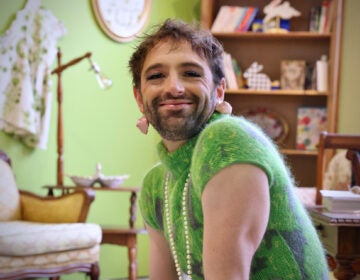Woodmere exhibit follows Philly’s black artists through a tumultuous half-century

A statuette by Meta Vaux Warrick Fuller (1914) is juxtaposed with Barbara Chasea-Riboud's Time Womb (1970) in the Woodmere Art Museum's look at black artists in Philadelphia. (Emma Lee/WHYY)
Hanging on a wall of the first gallery of the Woodmere Museum’s exhibition “We Speak: Black Artists in Philadelphia 1920s to 1970s,” is a 1948 portrait of W.E.B. Dubois. The black civil rights leader is in a classic pose, painted in sepia tones, seated behind a desk holding spectacles and looking thoughtful.
On the adjacent wall is a 1968 portrait of a black man with his hands in his pockets and wearing sunglasses, staring directly at the viewer. He is so tall, and his afro is so large, he doesn’t fit on the canvas. The two portraits represent the evolution from the intellectual New Negro movement to the later, more confrontational Black Power movement.
The man with the sunglasses and the afro is Philadelphia artist James Brantley, as painted by his friend Barkley Hendricks. They both attended the Pennsylvania Academy of the Fine Arts.
“Soon after I left the Academy, I joined a group called Recherche, an African-American collective of about 13, 14 artists,” said Brantley in an oral history interview recorded by the museum and included in the exhibition catalogue. “We toured this country, Europe, Brazil. Our works were seen around the world at that time.”
The exhibition of 70 works, along with a catalogue of 14 oral histories, traces layers of social and institutional networks that stitched together black artists for 50 years and bolstered their careers.
The Barnes Foundation, for example, prominently collected African art and works by contemporary African-American artists, and opened the collection to other black artists to study. According to an interview with photographer Don Camp, Albert Barnes would often have Horace Pippin over for dinner, and they would swap jokes all evening.
“Another thing we discovered was the strength of the Works Progress Administration graphic workshop,” said museum director Bill Valerio, referring to the New Deal program for artists.
“Because of the specific equilibrium of personalities, it was particularly open to black artists and printmakers. We have Dox Thrash and Sam Brown and Raymond Steth, who were given the opportunity to experiment with the medium and create impressive bodies of work.”
The exhibition’s scope — the ’20s to the ’70s — begins with the start of the New Negro movement, which encouraged black artists to look to Africa for inspiration, and ends with the start of the African American Museum of Philadelphia, which opened in 1976.
In between, the Woodmere found a range of official programs and informal collectives bolstering the careers of artists to a degree not seen in other American cities, say the curators.
Curator Rachel McCay points to the Pyramid Club, a popular black social club in the 1940s and 1950s that staged its own exhibitions of local and national artists.
“Black Philadelphians could not go to certain restaurants, so it was a club with a bar and amazing food,” said McCay. “There were parties, and it published pictorial books showing activities of black Philadelphians. It was the center of social and culture life.”
In an interview transcribed in the catalogue, Moe Brooker praised the prominent white artist Julius Bloch, who had refused to show his work in the Philadelphia Sketch Club when it denied black artists. Instead, he would show at the Pyramid Club.
The exhibition also features work by Barbara Bullock, who was associated with the Ile Ife Black Humanitarian Center, run by choreographer Arthur Hall in the 1970s and 1980s.
“As Ile Ife grew, our interest in Africa became even stronger. I think there was a need for it in the 1970s,” said Bullock in an interview included in the show catalogue. “Black artists were really coming out and proclaiming who they were and where they came from by exploring their connections with Africa.”
Some work in the exhibition feels no need to proclaim itself as African-American. Many abstract paintings by Moe Brooker, for example, do not make obvious ties to any racial identity.
“We predominately see representative imagery — our collection has more representative imagery than abstraction. But it’s not true that black artist were not painting abstractly,” said McCay. “Certain artists feel that there’s an expectation: If the art doesn’t look like it’s made by a black artist, it will not be collected.”
WHYY is your source for fact-based, in-depth journalism and information. As a nonprofit organization, we rely on financial support from readers like you. Please give today.





